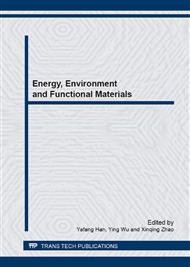p.92
p.97
p.102
p.106
p.111
p.117
p.123
p.128
p.135
Study on the Recovery and Recycling Standard System of Abandoned Fluorescent Lamps in China
Abstract:
Compared to incandescent bulbs, the advantages of the fluorescent lamps (such as less energy consumed and longer life expectancy) have greatly contributed to their rising use all around China, which leads to an increase in the number of the abandoned fluorescent lamps when they reach their end of life. However, their recovery and recycling (R&R) rate is still at a low level because it is lacking a complete standard system. In order to raise the R&R rate of abandoned fluorescent lamps in China. In this investigation the characteristics of the R&R standard system of abandoned fluorescent lamps in the developed countries has been analyzed, the deficiencies of the existing R&R standards studied, and a framework of the system suitable for China built.
Info:
Periodical:
Pages:
111-116
Citation:
Online since:
April 2014
Authors:
Keywords:
Price:
Сopyright:
© 2014 Trans Tech Publications Ltd. All Rights Reserved
Share:
Citation:


